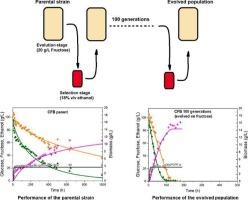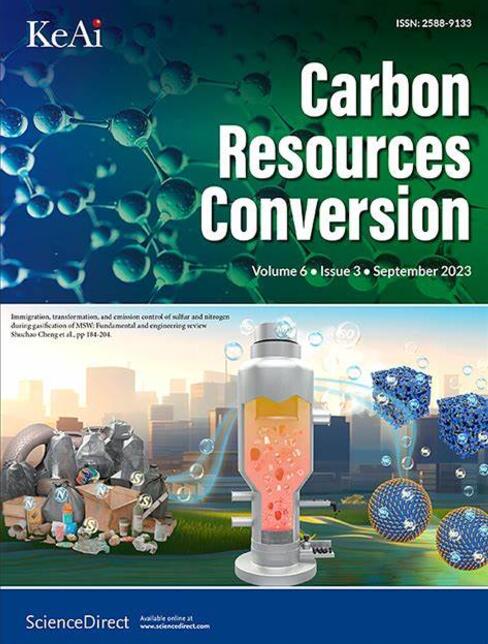通过单一适应性实验室进化策略同时提高酿酒酵母菌株的亲果性和乙醇耐受性
IF 7.5
3区 环境科学与生态学
Q2 ENERGY & FUELS
引用次数: 0
摘要
酿酒酵母是酿酒工业中使用的主要酵母。其天生的嗜糖性导致葡萄汁在酒精发酵过程中葡萄糖和果糖消耗的差异,再加上发酵液中积累的乙醇的抑制作用,可能导致发酵停滞或缓慢。在本研究中,我们实现了一种适应性实验室进化策略,即在20 g/L的果糖肉汤中进行酒精发酵,然后在高浓度乙醇环境中进行细胞选择,采用两种不同的酿酒葡萄球菌菌株CFB和BLR。经过100代的进化,每个菌株产生的进化群体表现出不同的发酵能力。源自CFB菌株的一个进化群体在170小时内将100 g/L葡萄糖和100 g/L果糖的合成肉汤发酵至干燥,而亲本菌株在孵育1000小时后仍未完成发酵。通过动力学模型计算本研究亲本群体和进化群体以及先前研究获得的乙醇耐受群体在100 g/L葡萄糖和100 g/L果糖的合成肉汤中生长的参数,并相互比较,以确定进化对菌株生化行为的影响。最后,在200 g/L的果糖合成肉汤发酵中,只有CFB菌株衍生的进化群体的发酵行为比其亲本菌株有所改善。本文章由计算机程序翻译,如有差异,请以英文原文为准。

Simultaneous improvement of fructophilicity and ethanol tolerance of Saccharomyces cerevisiae strains through a single Adaptive Laboratory Evolution Strategy
Saccharomyces cerevisiae is the main yeast used in the winemaking industry. Its innate glucophilicity provokes a discrepancy in glucose and fructose consumption during alcoholic fermentation of grape must, which, combined with the inhibitory effect of ethanol accumulated in the fermentation broth, might lead to stuck or sluggish fermentations. In the present study, we realized an Adaptive Laboratory Evolution strategy, where an alcoholic fermentation of a 20 g/L fructose broth was followed by cell selection in a high ethanol concentration environment, employed in two different S. cerevisiae strains, named CFB and BLR. The evolved populations originated from each strain after 100 generations of evolution exhibited diverse fermentative abilities. One evolved population, originated from CFB strain, fermented a synthetic broth of 100 g/L glucose and 100 g/L fructose to dryness in 170 h, whereas the parental strain did not complete the fermentation even after 1000 h of incubation. The parameters of growth of the parental and evolved populations of the present study, as well as of the ethanol tolerant populations acquired in a previous study, when grown in a synthetic broth of 100 g/L glucose and 100 g/L fructose, were calculated through a kinetic model, and were compared to each other in order to identify the effect of evolution on the biochemical behavior of the strains. Finally, in a 200 g/L fructose synthetic broth fermentation, only the evolved population derived from CFB strain showed improved fermentative behavior than its parental strain.
求助全文
通过发布文献求助,成功后即可免费获取论文全文。
去求助
来源期刊

Carbon Resources Conversion
Materials Science-Materials Science (miscellaneous)
CiteScore
9.90
自引率
11.70%
发文量
36
审稿时长
10 weeks
期刊介绍:
Carbon Resources Conversion (CRC) publishes fundamental studies and industrial developments regarding relevant technologies aiming for the clean, efficient, value-added, and low-carbon utilization of carbon-containing resources as fuel for energy and as feedstock for materials or chemicals from, for example, fossil fuels, biomass, syngas, CO2, hydrocarbons, and organic wastes via physical, thermal, chemical, biological, and other technical methods. CRC also publishes scientific and engineering studies on resource characterization and pretreatment, carbon material innovation and production, clean technologies related to carbon resource conversion and utilization, and various process-supporting technologies, including on-line or off-line measurement and monitoring, modeling, simulations focused on safe and efficient process operation and control, and process and equipment optimization.
 求助内容:
求助内容: 应助结果提醒方式:
应助结果提醒方式:


